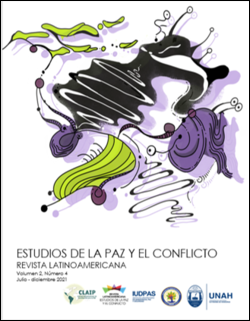Análisis espacial de violencia homicida en la región norte de Centroamérica (2019-2020)
DOI:
https://doi.org/10.5377/rlpc.v2i4.11820Palabras clave:
Homicidios, violencia, región norte de Centroamérica, patrón espacial, zonas calientes, zonas fríasResumen
La literatura sobre análisis espacial ha demostrado que la violencia homicida no se distribuye de forma aleatoria en el territorio, sino que tiende a aglomerarse en espacio y tiempo. Por ello, este estudio pretende identificar, en pleno contexto de pandemia por Covid-19, cuáles son los patrones espaciales de violencia homicida en la región norte de Centroamérica. Dado el enfoque cuantitativo del estudio, se utilizaron técnicas de análisis exploratorio de datos espaciales para identificar patrones de asociación espacial, así como los mapas Lisa (I de Morán Local) para la clasificación de los patrones espaciales. La información de los homicidios a nivel municipal se recolectó por medio de las instituciones policiales de Guatemala y El Salvador. En el caso de Honduras, la información se descargó del portal de datos abiertos del Sistema Integrado de Información para Políticas de Convivencia y Seguridad Ciudadana. Metodológicamente, se creó una base de datos en Excel, los cálculos estadísticos se realizaron con GeoDa y la elaboración de los mapas en QGis. Los resultados evidenciaron una paradoja y es que, a pesar del decrecimiento a nivel general de las tasas de homicidio en la región producto del cierre de los países (lockdown), también se observó un incremento considerable de municipios considerados como zonas calientes emergentes, con patrón por contagio, relacionados con los cambios de los nodos, las rutas y los límites de la interacción social provocados por las restricciones de movilidad de los gobiernos. Asimismo, se evidenció que la violencia se ha desplazado de las grandes ciudades hacia ciudades más pequeñas como el caso de Zacapa en Guatemala y Yoro en Honduras. Por otro lado, las zonas consideradas “frías” son limitadas en Honduras y El Salvador. En cambio, en Guatemala, hay un considerable número de municipios en esta última categoría. Esta investigación sobre patrones espaciales espera contribuir a comprender, de mejor manera, el fenómeno multicausal de los homicidios y servir a tomadores de decisiones a focalizar las intervenciones en materia de seguridad sin olvidar el abordaje multidisciplinario.
Descargas
962
HTLM 377
XLM 80
EPUB 108
Publicado
Cómo citar
Número
Sección
Licencia
Los contenidos de la revista se publican bajo licencia Creative Commons Reconocimiento 4.0 (CC BY 4.0). Esta licencia permite a terceros compartir (copiar y redistribuir el material en cualquier medio o formato) y adaptar (remezclar, transformar y crear a partir del material para cualquier finalidad, incluso comercial), siempre que se reconozca la autoría y la primera publicación en esta revista (Revista Latinoamericana Estudios de la Paz y el Conflicto, Universidad Nacional Autónoma de Honduras - Consejo Latinoamericano de Investigación para la Paz, DOI de la obra), se proporcione un enlace a la licencia y se indique si se han realizado cambios en ésta. Los términos de la licencia están disponibles online en http://creativecommons.org.




